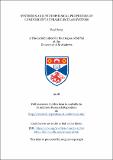Synthesis and photophysical properties of luminescent supramolecular systems
Abstract
Supramolecular chemistry has been developed in decades, and a large number of well-defined structures have been built by the utilizing of hydrogen bonds, coordination bonds and etc. However, the research on their photophysical properties is still rare. The high concentration of chromophores in supramolecular structures makes it possible to research the interactions between emitters in designed configurations, which is difficult to be achieved in traditional methods. Also, the localized luminescent units in individual sites of supramolecular systems can decrease the self-quenching of emitters theoretically, and their photoluminescence quantum yields (PLQYs) are expected to be improved.
This thesis focuses on synthesizing and exploring the photophysical properties of photoactive supramolecular systems, and contains work in three major areas. Firstly, a series of water soluble iridium complexes with terminal adamantyl groups were synthesized and used in the self-assembly with cyclodextrin vesicles (CDVs) through weak interactions. The effects on their photophysical properties brought by the interactions between CDV surface and iridium complexes were studied, as well as their potential application as bio-imaging probes. As expected, this group of iridium complexes showed enhanced emission intensity after being anchored to the CDV surface, and aggregated to perinuclear region in cell culture experiments. The second part involved the synthesis of an iridium complex based metalloligand, which was used to construct a supramolecular cage. The photophysical properties of both metalloligand and coordination cage were explored. Even though the photophysical properties of supramolecular cage were not improved compared with its unit complex, this system provided a different configuration to a former supramolecular system which was built from similar metalloligands and published by our group. The final part is the study of a series of luminescent [2+2] Schiff-base macrocycles. These macrocycles were synthesized from carbazole based luminescent dialdehyde molecules, and the photophysical properties of building units and macrocycles were measured in solution and solid states. These macrocycles also exhibited specific recognitions to Fe (III) in aqueous systems as luminescent probes.
Type
Thesis, MPhil Master of Philosophy
Collections
Items in the St Andrews Research Repository are protected by copyright, with all rights reserved, unless otherwise indicated.

